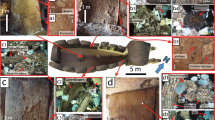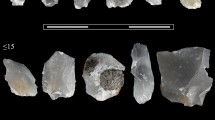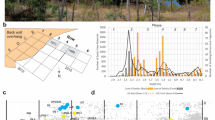Abstract
There have been many mathematical or astronomical explanations of the construction of certain elements at Stonehenge1–9. In 1979 a small salvage excavation at the site resulted in the chance discovery of a prehistoric pit dug to take a standing stone. The recognition that such substantial structures can exist unknown at Stonehenge is important to those who seek alignments or patterns in the locations of neolithic features. That ‘known’ arrangements could be affected by such unexpected discoveries is here illustrated with a preliminary reassessment of the significance of the Heelstone and the Station Stones (a full description of all aspects of Stonehenge is given in ref. 10).
This is a preview of subscription content, access via your institution
Access options
Subscribe to this journal
Receive 51 print issues and online access
$199.00 per year
only $3.90 per issue
Buy this article
- Purchase on Springer Link
- Instant access to full article PDF
Prices may be subject to local taxes which are calculated during checkout
Similar content being viewed by others
References
Hawkins, G. S. Nature 200, 306–8 (1963).
Hawkins, G. S. Nature 202, 1258–61 (1964).
Hoyle, F. Nature 211, 454–6 (1966).
Newham, C. A. Nature 211, 456–8 (1966).
Colton, R. & Martin, R. L. Nature 213, 476–8 (1967).
Colton, R. & Martin, R. L. Nature 221, 1011–12 (1969).
Robinson, J. H. Nature 225, 1236–7 (1970).
Newton, R. R. & Jenkins, R. R. Nature 239, 511–2 (1972).
Atkinson, R. J. C. Nature 275, 50–2 (1978).
Atkinson, R. J. C. Stonehenge (Penguin, Harmondsworth, 1979).
Clark, R. M. Antiquity 49, 251–66 (1975).
Newall, R. S. Antiquity 3, 75–88 (1929).
Hoare, R. C. The Ancient History of South Wiltshire, 144 (William Miller, London, 1812).
Long, W. Wiltshire Archaeol. nat. Hist. Mag. 16, 33 (1876).
Lukis, W. C. Proc. Soc. Antiquaries 7, 2nd Ser., 268–71 (1877).
Newall, R. S. Wiltshire Archaeol. nat. Hist. Mag. 61, 93 (1966).
Atkinson, R. J. C. Stonehenge, 203 (Penguin, Harmondsworth, 1979).
Hawley, W. Antiquaries J. 1, 30 (1921).
Atkinson, R. J. C. Stonehenge, 78–79 (Penguin, Harmondsworth, 1979).
Atkinson, R. J. C. Stonehenge, 70 (Penguin, Harmondsworth, 1979).
Atkinson, R. J. C. Stonehenge, 33 (Penguin, Harmondsworth, 1979).
Author information
Authors and Affiliations
Rights and permissions
About this article
Cite this article
Pitts, M. Stones, pits and Stonehenge. Nature 290, 46–47 (1981). https://doi.org/10.1038/290046a0
Received:
Accepted:
Published:
Issue Date:
DOI: https://doi.org/10.1038/290046a0
Comments
By submitting a comment you agree to abide by our Terms and Community Guidelines. If you find something abusive or that does not comply with our terms or guidelines please flag it as inappropriate.



